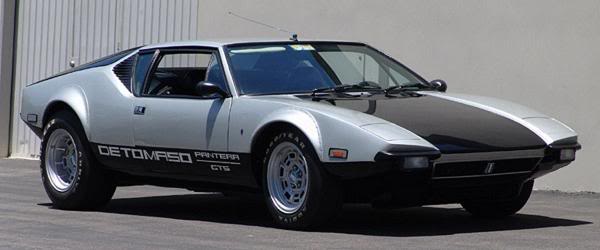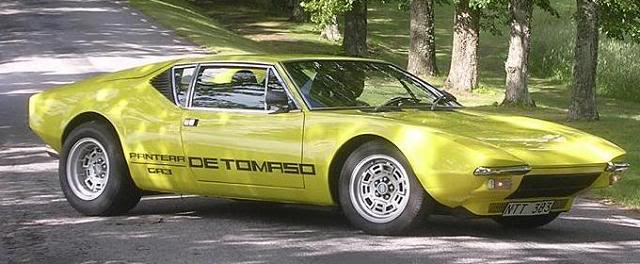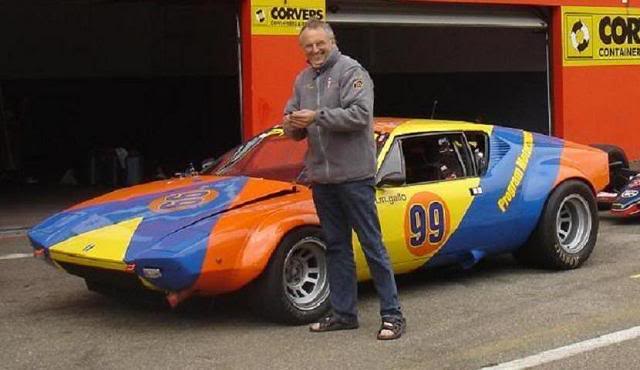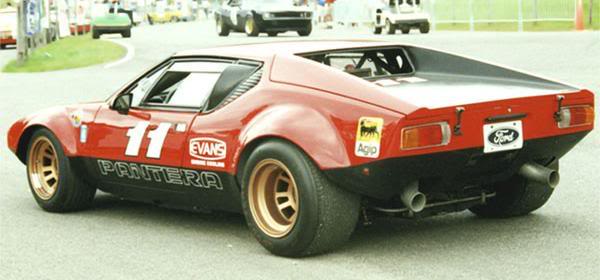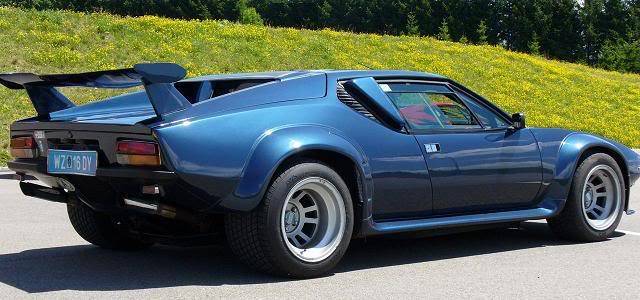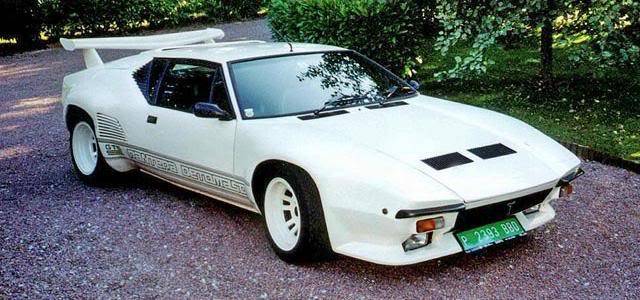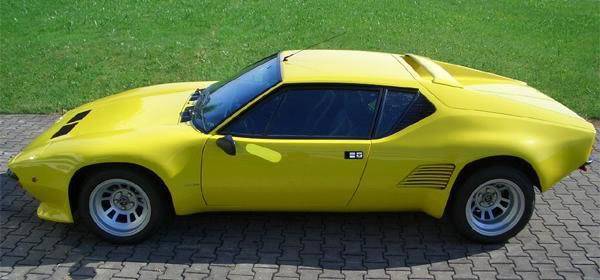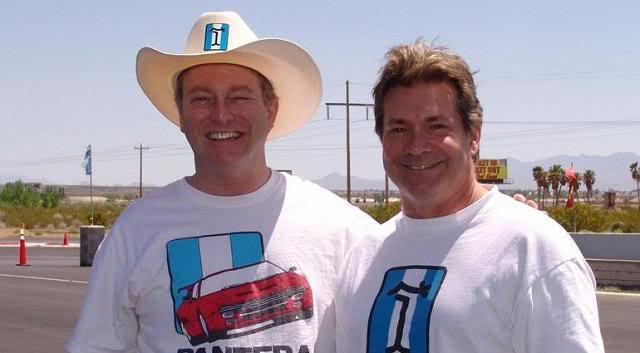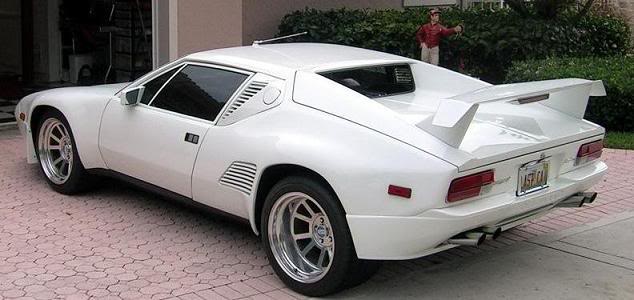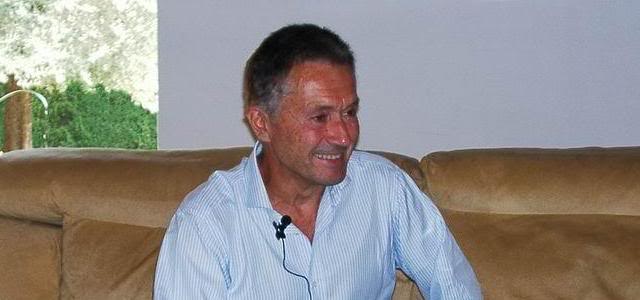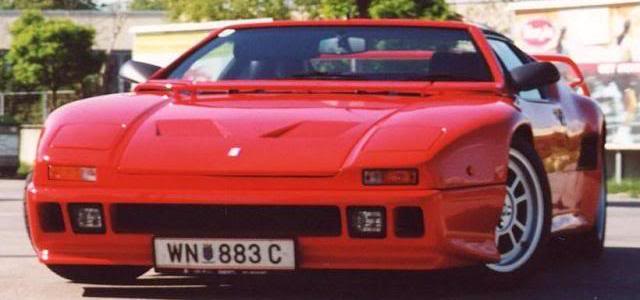|
Although the Pantera had been designed to Ford's specification for the North American market DeTomaso found there was a demand for the Pantera in Europe and other international markets as well and was selling Ford spec Panteras in these markets through their own network of distributors. Not satisfied with the specification of Ford's Pantera, a flurry of development occurred from fall of 1971 through spring of 1972 that resulted in 3 new models for the European market and a racing program for the 1972 World Endurance Racing Series. The evolution of the Pantera for the European market began only seven months after the high volume assembly lines had launched in Turin and Modena. I assume DeTomaso wanted to improve the Pantera's viability in the European market and prepare it to survive without Ford as a customer. Whereas the first Pantera had been Ford's Pantera, these new models were DeTomaso's Panteras!
DeTomaso's first new Pantera was unveiled in November 1971, as previously mentioned this model was named the Pantera GTS. The competition for sports car sales in Europe included vehicles offered by Ferrari, Lamborghini and Maserati. Better performance and more refinement were required for the Pantera to be competitive against these rivals. The first GTS was assembled on chassis 2014. The GTS offered performance improvements such as wider magnesium wheels (15" x 8" and 15" x 10") with 50 series Pirelli P7 tires (225/50VR15 and 285/50VR15), ventilated brake disks, higher rate suspension springs, an improved exhaust system and Holley model R4777 Carburetor. The mounting location of the steering rack assembly was relocated to reduce roll understeer. Cosmetically it featured small wheel well flares and a paint scheme that blacked-out the sides of the car below the beltline and the trunk and engine compartment hoods (bonnets). The interior featured the use of higher quality upholstery materials instead of the man made materials employed in the Ford spec Pantera. The Pantera GTS became the foundation for a series of wide body Panteras and 2 racing Panteras.
Pirelli's premium line of street legal tires, the P7, had just added tires with aspect ratios less than 50%. These new ultra-wide low aspect ratio tires were all the rage amongst sports car enthusiasts. The widest tire made by Pirelli had a 345 mm cross section, 345/35VR15! DeTomaso designed a wider set of wheel well flares and wider 15" x 13" ten spoke magnesium wheels to fit this tire on the rear of the GTS. The front of the GTS also received wider wheel well flares, 15" x 10" wheels and 285/40VR15 tires. It is common in the auto trade to refer to cars with flared wheel wells or bulging fenders as "wide bodies" and this is the nickname enthusiasts have given these Panteras with the flared wheel well arches. Wide body Panteras were customarily fitted with higher gear ratios in the ZF transaxle, 4.01:1 or 3.77:1, because the 345/35VR15 rear tire is only 24.5" in diameter, compared to the 26.2" diameter of the 285/50VR15 rear tire of the GTS. This wide body option for the GTS was named the GT4 by DeTomaso; however some Panteras so equipped were still documented as GTS Panteras by the factory. The first six GT4 Panteras were assembled in December 1971 through April 1972; the chassis numbers are 2263, 2342, 2343, 2344, 2823 and 2824.
The Group 3 race car was the first of the two race versions developed. Beyond the improvements included with the GTS it added further features strictly for racing including a plexiglass rear window that allowed supports for the rear suspension to pass through holes in the window and attach to a roll bar in the passenger compartment. It also included deletion of sound deadening material, a brake system employing Lockheed 3 piston calipers, heavy duty rear axles, racing seats, stiffer suspension with Koni shock absorbers and adjustable anti-sway bars, tail pipes with modified "straight through" mufflers, a high capacity intake manifold and carburetion system and a high capacity oil pan. The Group 3 Pantera was available by special order from the factory from 1972 through 1984. The group 3 Pantera with the earliest assembly date known to me is chassis 2661, assembled in February 1972. A second group 3 Pantera was assembled on a left-over push button chassis, chassis 1070. This group 3 was assembled in March 1972 so while it has the lowest chassis number it has the second earliest assembly date.
The decision was made around November 1971 to race the Pantera in the 1972 season of the World Endurance Racing Series, the series in which the LeMans 24 hour endurance race is run. The Pantera would race in the GT class (group 4), a class dominated by Ferrari and Porsche. Ferrari race car driver and development engineer Michael Parkes was hired away from Ferrari to develop the Pantera for this series and drive the Pantera too. Each of DeTomaso's 5 European distributors were asked to field a team in the series.
The features that are the backbone of a race car are reduced weight, a powerful motor, the best tires allowed by the rules and brakes with tremendous stopping power. The Group 3 Pantera was the starting point for the development of these Group 4 race cars. The chassis were lightened with holes everywhere. Aluminum panels for the doors and bonnets replaced the steel panels of the production cars. A 351C racing motor was sourced from Bud Moore engineering of the USA and an unmuffled exhaust system was attached to it. Installation of the GT4 wheel well flares allowed Mike Parkes to fit class leading Goodyear racing tires. The magnesium wheels from the front of the GT4 were utilized, but wider ten spoke 15" x 14" rear wheels were installed in the rear. Four piston Girling brake calipers and massive disks performed the stopping chores. Other details included a stripped interior, plexiglass side windows, an air to oil cooler for the motor oil and bronze suspension bushings. The Group 4 Pantera was not intended to be a new model offered to the public like the Group 3 Pantera, it was a one time run of race cars for the 1972 and 1973 seasons of the World Endurance Racing Series. A fixed number (eight) of Group 4 Panteras were built in April through December of 1972; the chassis numbers are 2858, 2859, 2860, 2861, 2862, 2872, 2873 and 2874. When the demand for Group 4 Panteras exceeded these eight cars, the six GT4 Panteras mentioned previously were brought up to Group 4 specification and sold to race teams. Ford had acquired full ownership and control of both the Ghia and Vignale coachworks by 1971, making DeTomaso the only non-Ford link in an otherwise 100% Ford chain. Vignale (owned by Ford) delivered finished coaches to DeTomaso, who installed the drive train and suspension and then shipped the completed vehicles to a North American Distribution company that was also owned by Ford. That is a very unusual business arrangement. US Ford did not want to remain involved in any phase of the Pantera manufacturing business when the decision was made to stop selling them. Besides putting an end to Pantera shipments to North America in August 1974, Ford also shut down the coach assembly operation at Vignale in July 1974. DeTomaso not only lost their major customer, they lost their coach supplier at the same time. DeTomaso no longer needed the high volume assembly line in Modena so it was shut down as well. They scaled back assembly from 40 Panteras per week to about 2 per week when Ford stopped buying them. They ceased assembly of the Ford spec Pantera and made the Pantera GTS the base road version. DeTomaso continued to assemble Panteras throughout 1974 and 1975 using a reserve of about 175 left over and unfinished coaches purchased from Ford/Vignale. Few Panteras were assembled in 1976. In addition to the GTS, DeTomaso continued to offer the Group 3 race car and the "wide body" GT4. This 3 model line up remained the same through out the last 5 years of the decade of the 1970s. It was necessary for DeTomaso to contract other coachbuilders to assemble the Pantera coaches when the reserve of Vignale built coaches had been depleted. They had no coachbuilding facilities of their own and by 1976 Vignale no longer existed. Vignale's new owner, Ford, had opted to close down the business completely. The first coachworks contracted was Carrozzeria Maggiora, and about 2 years later they contracted Carrozzeria Embo. DeTomaso and Carrozzeria Embo went on to have a long and amicable business relationship. DeTomaso made a jump in chassis numbering between the last Vignale coach, 7554 (?), and the first Maggiora coach, 9001. Bill Van Ess, an esteemed historian of the DeTomaso marque, claims the Pantera with chassis 9001 was assembled on June 13, 1976. One odd-ball Pantera has a chassis number that falls within the gap in the chassis numbers, a group 3 Pantera with chassis 8472.
Lamborghini introduced a "wide body" version of the Countach in 1978, the LP400S, and fitted it with Pirelli 345/35VR15 P7 tires; the same tires DeTomaso had used for the GT4 in 1972! I assume DeTomaso thought it was time to spruce up the wide body Pantera and keep up with the competition at Sant'Agata. So the GT4 evolved into a new model known as the GT5. The GT5 was officially introduced to the public in 1980, DeTomaso claims the first GT5 was chassis 9250; however several GT5 Panteras bearing lower chassis number are known to exist. Like the GT4 the GT5 featured the same mechanical specification and coachwork as the GTS with the addition of fiberglass flares to the wheel arches, a deep frontal air dam, ground effects side skirts, the same 10 spoke magnesium wheels and those outrageously wide Pirelli P7 tires. The GT5 interior was more plush than that of the GTS. A popular option offered with the GT5 was a large delta wing rear spoiler, similar to the spoiler found on the Countach. Whereas the wide body GT4 had been an option for GTS buyers, the GT5 was considered a "stand-alone" model, the upscale version of the Pantera. In the 1980s the wide body look was "IN"!
The wide body GT5 evolved again in 1985 with the introduction of the GT5-S. I assume this evolution was inspired by the subtle lines of the 1984 Ferrari Testarossa because the GT5-S replaced the distinctive fiberglass wheel arch flares of the GT5 with steel flares more subtly integrated into the lines of the coachwork including rear wheelhouse "strakes" reminiscent of those found on the Testarossa. The first GT5-S, chassis 9375, was assembled in 1984 and was used as a show car; the remaining GT5-S Panteras have 1985 or later build dates. The final GT5-S, chassis 9562, was assembled in 1990. Pantera assembly had by that time slowed to a pace of one every two weeks. With only a few exceptions, all of the 188 Panteras assembled between 1985 and 1990 were GT5-S models. It became necessary to find a substitute motor for the Pantera during the latter half of the 1980s. US Ford had last manufactured the 351C in 1974, and Ford of Australia ceased manufacture of the 351C in 1984. DeTomaso's Australian distributor had stockpiled a large number of the 351C motors prior to the end of its production and DeTomaso had sourced 351C motors from their Australian distributor since that time. However, the reserve of motors stored in Australia was depleted in 1986 and DeTomaso made the transition to Ford's 351W V8 sourced from US Ford; the first Pantera with a 351W motor installed is chassis 9483, a GTS special ordered by a US customer with a build date of September 1986 (technically this Pantera's motor was a "Clevor", a 351W block topped by Australian 302C heads).
Although Ford had not imported Panteras to North America since 1974, a substantial number of the later model Panteras were made available to North American enthusiasts due to the efforts of several American businessmen who were Pantera enthusiasts themselves. These gentlemen imported and sold small numbers of GTS, GT5 and GT5-S Panteras in North America as grey market vehicles between 1979 and 1990. Grey market importers included the California based duo of Barry Gale and Steve Hitter (Panteramerica), George Stauffer of Wisconsin (Stauffer Classics Ltd) and Steve Wilkinson of California (Panteras by Wilkinson). Kirk Evans of Ohio (Amerisport Industries) played a big part in bringing Panteras into the US during the 1980s by assisting the importers with the governmental red tape of exhaust emissions certification. Mr. Evans also imported GT5-S Panteras directly to the US in a unique arrangement with DeTomaso, his Panteras are known as Amerisports. Although DeTomaso transitioned to 351W motors in 1986, Amerisport continued to install 351C motors in the GT5-S Panteras they imported to North America. One of Kirk's GT5-S Amerisport Panteras, chassis 9494, was the last new Pantera imported to the US.
GT5-S assembly was phased out in 1990 with the introduction of a new and final version of the Pantera, the Pantera Si. The coachwork of the Si was updated by Marcello Gandini, who had created the coachwork for the 1990 Lamborghini Diablo. The coachwork of the Si is reminiscent of the Daiblo's in some aspects, although the rear spoiler is often compared with the spoiler of the Ferrari F40 (1987 - 1992). The Si also has a spoiler at the base of the windshield like the one found on the Maserati Shamal, another sports car designed by Gandini (DeTomaso controlled Maserati 1975 - 1993). Along with the new coachwork the Si offered further mechanical refinement to the Pantera, including improved front suspension geometry, a tubular steel rear sub-frame, 17 inch magnesium wheels, 235/45ZR17 front tires, 335/35ZR17 rear tires, Brembo brakes, a 5.0 liter fuel injected Ford V8 motor rated at 305 horsepower and the transition to a Getrag six speed transaxle in the last four cars assembled. The pace of Pantera Si assembly averaged one car every four weeks. There is a small gap in chassis numbering between the last GT5-S, chassis 9562, and the first Pantera Si, chassis 9601. The last Pantera Si, chassis 9641, was assembled in 1993. Pantera construction was phased out that year as a new sports car named the Guara was unveiled before the public. Guaras went on sale to the public in 1994. Two events occuring in 1993 made that year a turning point in the fortunes of DeTomaso Modena. 1993 witnessed the signing of the Maastricht treaty that marked the formal beginning of the European Union. DeTomaso found acquiring government loans to fund automotive ventures more difficult under the European Union than it had been with the Italian government. As a consequence it seems DeTomaso began liquidating assets in 1993 in order to acquire needed capital to fund its operation and new projects, such as construction of the Guara. The first asset to be liquidated was their stock in Maserati; the DeTomasos sold their controlling interest in Maserati to Fiat in 1993. Sadly, Alejandro DeTomaso was afflicted by a stroke in 1993 that left him permanently physically impaired and made it impossible for him to keep the pace he was accustomed to in operating his many businesses. Eventually Santiago DeTomaso, Alejandro DeTomaso's son, took his father's place at the helm of DeTomaso Modena S.p.A. |
